Make pine salve from local trees. It is a traditional drawing salve, that draws infections, slivers, and inflammation out of the body. Pine salve reduces pain and swelling, helping the body heal itself.
Pine (Pinus sp.) is an incredible gift. It is rich in woodsy essential oils and resins. Sometimes in North America, we look to the traditional healing remedies from Europe and the Middle East and ignore the ones that God gave us here. Myrrh and frankincense are lovely and expensive. Pine is free and just as beneficial for us as these more exotic plants.
You might find pine salve also called pine tar, pine tar salve, pine pitch salve, pine resin salve. It’s all the same product. This salve is dark and wonderfully aromatic. It can be used safely on humans as well as animals.
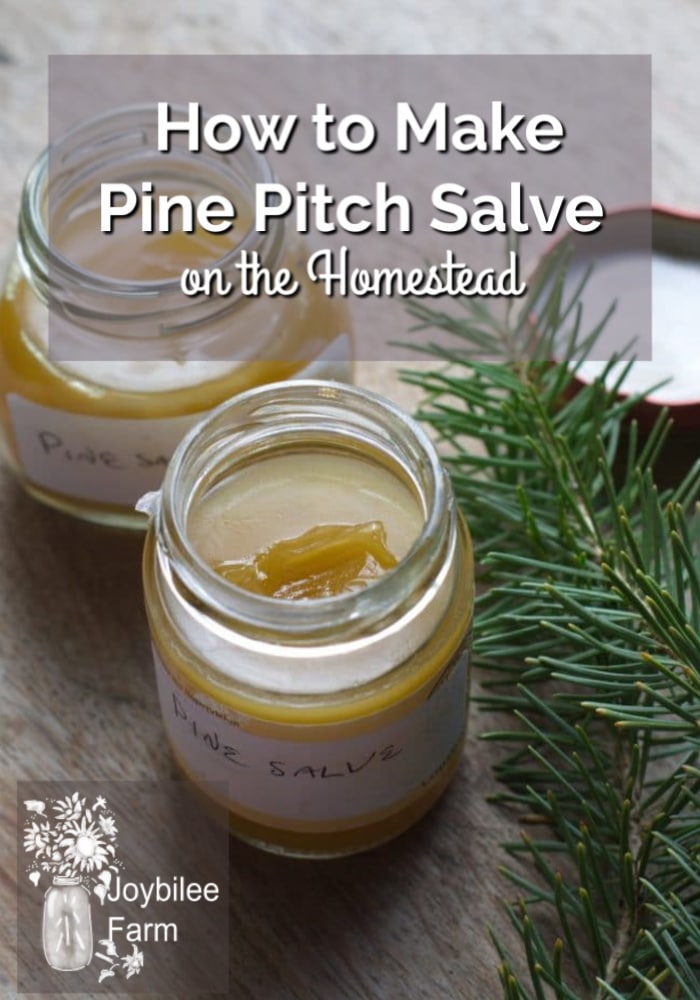
Pine trees produce sticky pine resin as a protective response to injury, insect assault, and fungal or bacterial stress. Look for the sticky pitch where there are broken branches or pine beetle assault. You may find beetle larvae encased in the pine pitch.
Collecting Pine Pitch to Render Oleoresin
Gather the raw resin from pine trees anytime from early spring until fall. You’ll find that spring resin is soft and sticky. It will harden as the season wears on. Soft resin is stickier to the touch but it renders more quickly. If you get sticky resin where you don’t want it, you can remove it with oil and soap. The harder, seasoned resin is drier to the touch and will take a little longer to render. Gather about 2 or 3 cups of resin to make 1 cup of rendered oleoresin.
The jars you use to render pine resin should be reserved for your yearly process of rendering pine resin. I use heavy glass jars with lids for this, but do not waste my best canning jars. The jars will be pretty sticky when you are done. I use empty glass peanut butter jars to render mine. Choose a glass jar with a lid and don’t use plastic. Even a tin will do if it has a lid.
When you are out collecting, fill the glass jars with pine resin and place the lid on to hold in the terpinene vapours. You want the medicinal benefits of the terpinenes in your oleoresin. This is not the same as the turpentine that you buy at the paint store, which is a simulated product created from petroleum.
When you collect the oleoresin, use a knife to make it easier to get the resin in. I never take all the resin from any one spot on the tree, just the outer part of the resin, leaving the inner resin to suffocate the bugs or heal the breach in the integrity of the tree’s bark.
Once the pine resin is enclosed in the jar, you can use your slow cooker or double boiler to render the pine resin without fear of making a sticky mess on your other cookware.
Removing Pine Pitch from Unwanted Places
When you get home you can clean your hands and your knife with vegetable oil or tallow to get the sticky resin off. If you get sticky resin where you don’t want it, you can remove it with oil and soap. Rub with liquid oil till you feel the resin dissolve and then follow up with a squirt of soap or dish detergent. It will all wash away.
Alcohol will remove the resin from your clothes with a little scrubbing. The follow up with a squirt of detergent. It takes a bit more work to get pine resin off of clothes than off of hands.
If you get your fingers sticky with the resin while in the field, the powdery yeast on the bark of aspen trees will help remove the tackiness from your fingers.
How to Make Pine Salve
Pine salve is a traditional drawing salve, that draws infections, slivers, and inflammation out of the body. It reduces pain and swelling, helping the body heal itself. One way it works is by increasing peripheral circulation by counter-irritation. While you could make pure pine salve with just pine oleoresin, beeswax, and oil, this recipe uses infused oils to work synergistically reducing pain and inflammation.
Pine is broadly antimicrobial. It is warming, stimulating, and increases blood flow. It is valuable as a chest rub for chest congestion. It can help with localized pain, inflammation, and infection. It’s also beneficial for old injuries and chronic inflammation. It is safe to take internally for sore throat and congestion.
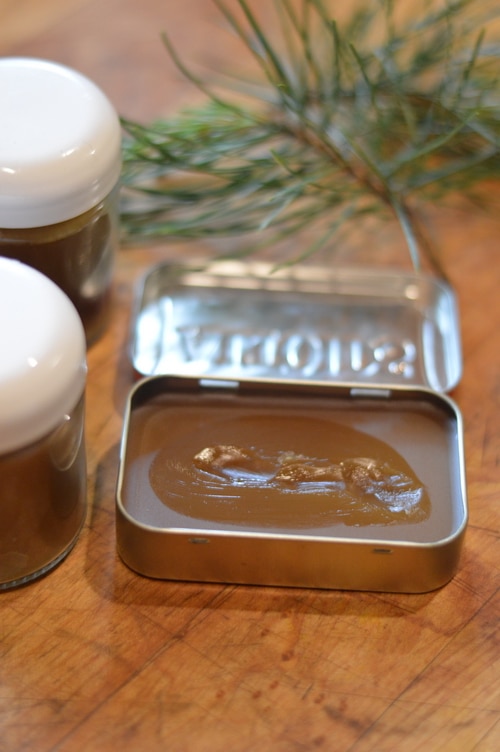

How to Make Pine Pitch Salve
- Prep Time: 2 hours
- Cook Time: 12 hours
- Total Time: 2 hours + 12 hours
- Yield: 14 ounces 1x
Description
Pine salve is a traditional drawing salve, that draws infections, slivers, and inflammation out of the body. It reduces pain and swelling, helping the body heal itself.
Ingredients
- ½ cup Pine oleoresin, rendered
- ¼ cup Beeswax, melted
- ¼ cup Calendula infused oil
- 2 tbsp. St. John’s Wort infused oil
- 2 tbsp. comfrey leaf infused oil
- ½ cup of a mixture of Yarrow, self-heal, chickweed, and plantain in an infused oil
- 20 drops tea tree essential oil
- 20 drops frankincense essential oil
Instructions
- Render the pine oleoresin by placing the jars you collected in your slow cooker. Fill halfway with water and turn it on medium heat. Simmer the water in the slow cooker, leaving the jars to render overnight or as long as necessary to turn the pine resin to liquid. Any crud and bugs in the resin will sink to the bottom of the jar. The clean pine oleoresin will be on top.
- Pour the clean oleoresin into another strong glass jar, being careful to only transfer the clean oleoresin. Leave any crud in the original collecting jar and set it aside. You can render more raw pine resin in that same jar.
- In the new jar that has the cleaned and rendered oleoresin, add the beeswax and infused oils. Place the jar back in the slow cooker or another double boiler, and simmer on low heat until the beeswax melts. Stir everything well so that the consistency of the salve is uniform. Remove from the heat.
- Add the essential oils, stirring until you can no longer see it. Pour the pine pitch salve into tins or glass jars with a wide mouth opening. Label and date.
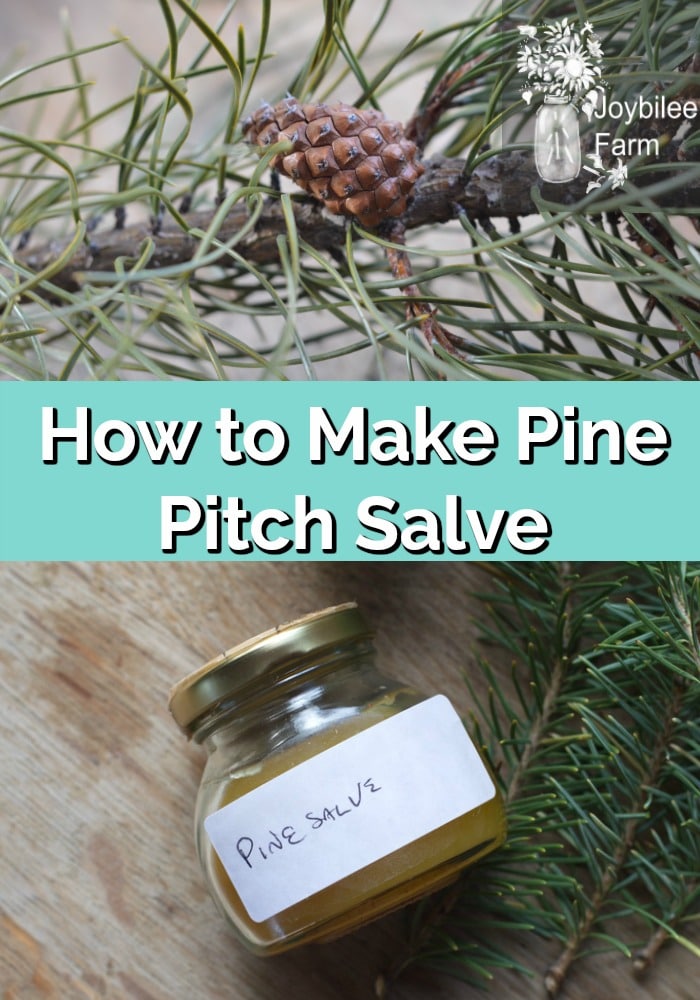
Pine Pitch Salve
Yield: 14 ounces in total. You’ll get 3 x 4-ounce tins, plus one 2 ounce tin for travel.
Ingredients:
- ½ cup Pine oleoresin, rendered
- ¼ cup Beeswax, melted
- ¼ cup Calendula infused oil
- 2 tbsp. St. John’s Wort infused oil
- 2 tbsp. Comfrey Leaf infused oil
- ½ cup of a mixture of Yarrow, self-heal, chickweed, and plantain in an infused oil
- 20 drops tea tree essential oil
- 20 drops frankincense essential oil
Method:
- Render the pine oleoresin by placing the jars you collected in your slow cooker. Fill halfway with water and turn it on medium heat. Simmer the water in the slow cooker, leaving the jars to render overnight or as long as necessary to turn the pine resin to liquid. Any crud and bugs in the resin will sink to the bottom of the jar. The clean pine oleoresin will be on top.
- Pour the clean oleoresin into another strong glass jar, being careful to only transfer the clean oleoresin. Leave any crud in the original collecting jar and set it aside. You can render more raw pine resin in that same jar.
- In the new jar that has the cleaned and rendered oleoresin, add the beeswax and infused oils. Place the jar back in the slow cooker or another double boiler, and simmer on low heat until the beeswax melts. Stir everything well so that the consistency of the salve is uniform. Remove from the heat.
- Add the essential oils, stirring until you can no longer see it. Pour the pine pitch salve into tins or glass jars with a wide mouth opening. Label and date.

How to Use Pine Salve
The aroma of this salve is wonderful even without the essential oils. You can leave them out without harming the beneficial effects of the salve.
Use pine pitch salve on painful joints, cuts, abrasions, or swollen injuries. You can use it as a chest rub or an inhalant for chest congestion. Some folks even use it as a lip balm.
It’s a little sticky going on but it is quickly absorbed by the skin and the stickiness goes away in just a few minutes.
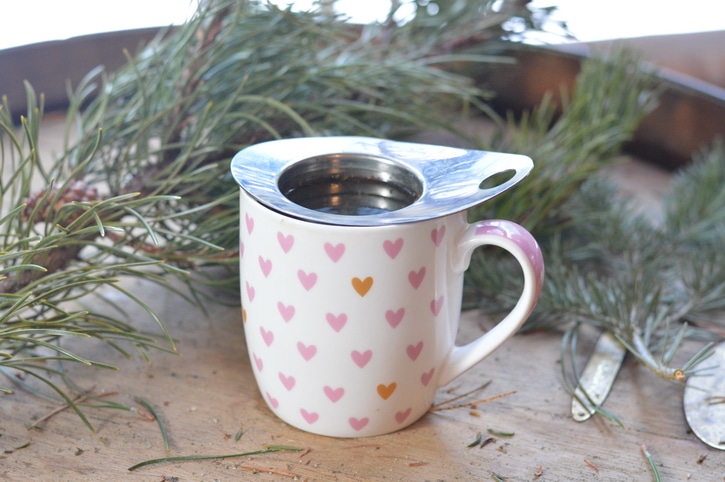
Other Gifts of the Pine Tree from Joybilee Farm
Harvesting Pine Tree for Medicinals
How to Make Pine Needle Tea for Vitamin C and Wellness
What If I Told You Your Christmas Tree Was More than Just a Decoration?
DIY Pine Forest Lotion Bar Recipe
I have a gift for you

Grab my free ebook and learn to make DIY herbal healing salves at home now, with 14 easy to follow recipes that use the herbs and wild plants growing close to home. Salve making is one of the easiest skills to learn in DIY Herbalism.


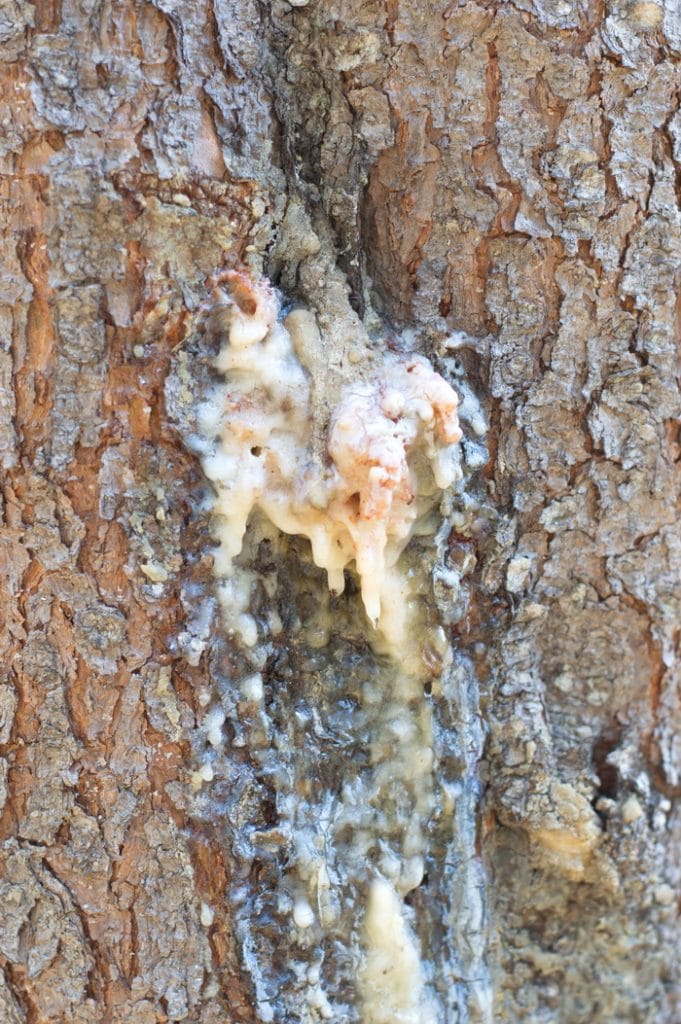

It is pine sap. All of it should dissolve in olive oil except the debris.
Hi just made some pine Oleoresin and I see that there is a lot of white sap stuff left in ThE bottom of the jar about a 3rd what can I use this for? soaps etc? Or natural pesticides? And would it be called gum terpentine and gum rosin
Thanks great recipe
So any pine sap that smells good can be used? In new england i cant wait to try. Sounds like
It will take a while to get 2 cups worth though? Thanks for the recipe
Hi, Nick
If you are using Mason Jars/Canning Jars the jars should be fine if you are adding water to your slow cooker insert, then adding the jars so that the water comes halfway up the side of the jar. The pine resin might need to be stirred in with the oil to break it apart. It does need a higher temperature to melt. If you are worried about the temperature with the jars you could add a canning jar ring to the bottom of the slow cooker and then rest your jar on top of the ring, to add a space between the bottom of the jar and your heating element. I hope this helps.
I am working on a combination of this with your Frankincense & Myhhr salve. One jar with Frankincense, Myhhr and Barberry root has been sitting for about 24 hours. The other has pine resin, both are using rice bran oil. The first jar seems good, but the pine is not completely melting and mixing into the oil. It is definitely melting some and i’m not sure if I should let it go on low longer or take the other jar out and then crank the heat up on the crockpot. I’m worried about the mason jar cracking, but I see you mention turning to medium. My crockpot has low and high. Using my IF thermometer on the jar / water the temp is showing between 170 / 180. I believe jumping from low to high will go up to the 250-300 range, is this ok for a glass jar or will it eventually melt in on low? Does it all really need to melt in? It is definitely less than what you are describing, but I opened it once and really can smell the difference, plus if I turn the jar upside down I can see it start to slowly fall to the bottom and form some sort of pine hot icicle.
I was planning to add in Shea butter, Lanolin & Ghee / Coconut oil mixture. I get “mechanics hands” from dermatomyositis and made another salve recently with those 3 ingredients and it has really been helping my skin. Do you think it would come out ok adding this in? I’m guessing I would need to add extra oil since this tends to thicken it a bit.
Great website, very helpful. Thanks.